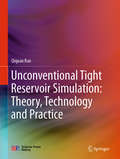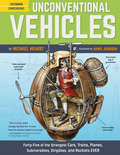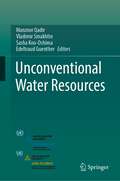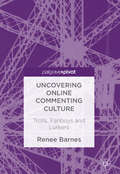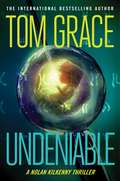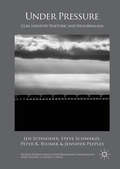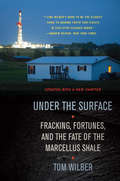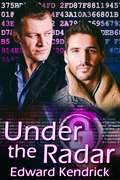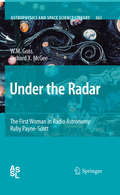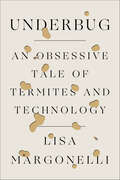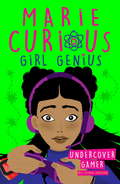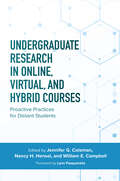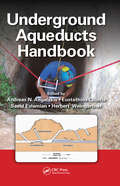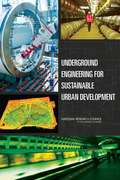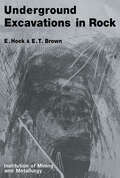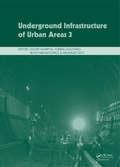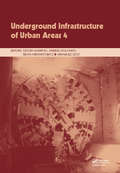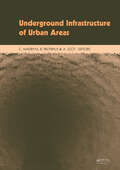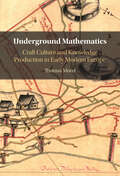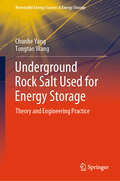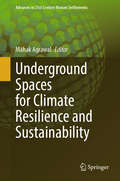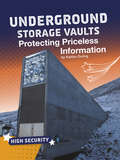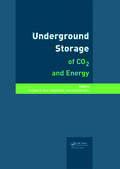- Table View
- List View
Unconventional Tight Reservoir Simulation: Theory, Technology and Practice
by Qiquan RanThis book systematically introduces readers to the simulation theory and techniques of multiple media for unconventional tight reservoirs. It summarizes the macro/microscopic heterogeneities; the features of multiscale multiple media; the characteristics of complex fluid properties; the occurrence state of continental tight oil and gas reservoirs in China; and the complex flow characteristics and coupled production mechanism under unconventional development patterns. It also discusses the simulation theory of multiple media for unconventional tight oil and gas reservoirs; mathematic model of flow through discontinuous multiple media; geological modeling of discrete multiscale multiple media; and the simulation of multiscale, multiphase flow regimes and multiple media. In addition to the practical application of simulation and software for unconventional tight oil and gas, it also explores the development trends and prospects of simulation technology. The book is of interest to scientific researchers and technicians engaged in the development of oil and gas reservoirs, and serves as a reference resource for advanced graduate students in fields related to petroleum.
Unconventional Vehicles: Forty-Five of the Strangest Cars, Trains, Planes, Submersibles, Dirigibles, and Rockets EVER
by Michael HearstThink you know vehicles? Think again!Unconventional Vehicles is a nonfiction collection of 45 of the strangest, most unconventional vehicles that have ever existed.Vehicles include an underwater battery-powered scooter, a carriage pulled by ostriches, a hot air balloon shaped like the Cathedral of Saint Gall, and five different jet packs.• Filled with history, science, technology, engineering, and interesting bits of trivia, all in one kid-appealing package• Part of the Uncommon Compendiums series• Vehicles range from submersibles to dirigibles.Unconventional Vehicles explores very strange modes of transportation for vehicle fans, rocket inventors, budding space-and-aeronautics experts, and anyone who's ever thought, "Why can't I ride a motorized suitcase through the airport?" Brimming with fascinating facts and diagrams presented with wit and humor, this book is sure to enthrall vehicle enthusiasts of every age.• Ideal for children ages 8 to 12 years old, especially those interested in vehicles and engineering• Author Michael Hearst brings his signature verve and humor to this fascinating read.• Young readers will devour all the substantive and silly content in this book, proving definitively that nonfiction is anything but dry.• A great pick for teachers, parents, grandparents, and caregivers• You'll love this book if you love books like Cars, Trains, Ships, and Planes: A Visual Encyclopedia of Every Vehicle by DK; Stephen Biesty's Incredible Cross-Sections by Stephen Biesty; and Cool Cars by Quentin Willson.
Unconventional Water Resources
by Vladimir Smakhtin Manzoor Qadir Sasha Koo-Oshima Edeltraud GuentherThe world is faced with a growing number of complex and interconnected challenges. Water is among the top 5 global risks in terms of impacts, which would be far reaching beyond socio-economic challenges, impacting livelihoods and wellbeing of the people.As freshwater resources and population densities are unevenly distributed across the world, some regions and countries are already water scarce. Water scarcity is expected to intensify in regions like the Middle East and North Africa (MENA), which has 6% of the global population, but only 1% of the world’s freshwater resources. Climate change adds to this complexity as it is leading to rainfall uncertainty and extended droughts periods, mostly in arid areas.Increasing water scarcity is now recognized as a major cause of conflict, social unrest and migration and at the same time water is increasingly considered as an instrument for international cooperation to achieve sustainable development. Tapping and assessing sustainably every available option in water-scarce areas is needed as pressure continues to build on limited water resources.The stark fact is that conventional water provisioning approaches relying on snowfall, rainfall and river runoff are not enough to meet growing freshwater demand in water-scarce areas. Water-scarce countries need a radical re-think of water resource planning and management that includes the creative exploitation of a growing set of viable but unconventional water resources for food production, livelihoods, ecosystems, climate change adaption, and sustainable development. Unconventional water resources are generated as a by-product of specialized processes; need suitable pre-use treatment; require pertinent on-farm management when used for irrigation; or result from a special technology to collect/access water.
Uncorked: Negotiating Science and Belief in the Natural Wine Movement
by Pablo Alonso González Eva Parga DansNatural wine is a captivating and rapidly evolving phenomenon in the world of viticulture and winemaking. This movement, characterized by minimal intervention, low or no chemical additives, and a focus on terroir-driven expressions of grapes, has ignited a passionate following among wine enthusiasts, sommeliers, and eco-conscious consumers. It's more than just a beverage; it embodies a philosophy that aligns with contemporary sustainability and wellness trends. Though natural wine enthusiasts have produced ample coverage of the natural wine movement in books, essays and films, academics have lagged behind in their examination of this global phenomenon. In Uncorked: Negotiating Science and Belief in the Natural Wine Movement, scholarly discussion reaches across disciplines to offer valuable insights for researchers, producers, wine enthusiasts and anyone with an interest in this movement. Exploring the relevance of natural wine offers a unique lens through which to examine the intersection of tradition, innovation, environmental stewardship, and the evolving tastes of modern consumers. Through the stories of the winemakers, the science behind natural fermentation, and the cultural and historical context, this book aims to provide a comprehensive look at how this movement is shaping the future of wine and our relationship with the natural world. Each essay from a thought leader in their respective field delves deep into the historical, ecological, and sociocultural dimensions of natural winemaking, shedding light on its ancient roots, ecological practices, and the philosophical underpinnings that drive the movement. Discussions of regulatory and consumer aspects will also elucidate the practical considerations of making and selling natural wine. Uncorked: Negotiating Science and Belief in the Natural Wine Movement is a groundbreaking edited book that offers a comprehensive and scholarly exploration ofthe world of natural wine. This interdisciplinary volume brings together leading experts in fields ranging from enology and sensory studies to anthropology and philosophy, creating a rich tapestry of insights into the production, consumption, and cultural significance of natural wine. Academics, winemakers and wine enthusiasts alike will be illuminated by this volume.
Uncovering Online Commenting Culture
by Renee BarnesIn today's digital world our social interactions often take place in the form of written comments. We chat, disagree, worship, vent, confess, and even attack in written form in public digital spaces. Drawing on scholarly literature from media and cultural studies, psychology and sociology, Uncovering Commenting Culture charts this commenting territory and outlines why we behave in these ways online. In this timely book, Renee Barnes provides a participatory model for understanding commenting culture that is based on the premise that our behaviours online-including those that cause us most the concern-are not so much an internet problem as a social problem. By looking at a wide variety of online commenting habitats, from the comment threads following news stories, through to specialist forums and social media platforms, the volume provides a comprehensive understanding of the role of online commenting in society and provides suggestions for how we might mitigate bad behaviours.
Undeniable (Nolan Kilkenny #6)
by Tom GraceEx-Navy SEAL Nolan Kilkenny receives a desperate plea for help from doctors frantic to save the life of a young boy with a deadly genetic disorder. The boy, who came to his parents through a blind adoption, has no known blood relatives. Nolan agrees to help, but as he is being prepped for surgery, the boy dies. Further genetic testing then reveals an astonishing truth: Nolan and the boy share the same biological father. Nolan must confront his own father to find out the truth behind the discovery, and uncovers a heinous blackmail plot and desperate victims and villains. <p><p> Undeniable, the sixth Nolan Kilkenny thriller from international bestselling author Tom Grace, takes Nolan into the brave new world of reproductive technology, where the building blocks of life are manipulated in a Petri dish, women lease their wombs like rental properties, and money trumps morality. In an age of rapid advances in human genetics, cloning and stem cell research, what seemed impossible just a few years ago is now a reality. DNA has been reduced from a miraculous molecule into a data storage device, and the information it contains is as easy to hack as any computer file. Undeniable is a novel that steps beyond the traditional parent-child relationship into a chilling new reproductive reality. Undeniable, the sixth Nolan Kilkenny thriller from international bestselling author Tom Grace, takes Nolan into the brave new world of reproductive technology, where the building blocks of life are manipulated in a Petri dish, women lease their wombs like rental properties, and money trumps morality. In an age of rapid advances in human genetics, cloning and stem cell research, what seemed impossible just a few years ago is now a reality. DNA has been reduced from a miraculous molecule into a data storage device, and the information it contains is as easy to hack as any computer file. Undeniable is a novel that steps beyond the traditional parent-child relationship into a chilling new reproductive reality.
Under Pressure
by Jen Schneider Steve Schwarze Peter K. Bsumek Jennifer PeeplesThis book examines five rhetorical strategies used by the US coal industry to advance its interests in the face of growing economic and environmental pressures: industrial apocalyptic, corporate ventriloquism, technological shell game, hypocrite's trap, and energy utopia. The authors argue that these strategies appeal to and reinforce neoliberalism, a discourse and set of practices that privilege market rationality and individual freedom and responsibility above all else. As the coal industry has become the leading target and leverage point for those seeking more aggressive action to mitigate climate change, their corporate advocacy may foreshadow rhetorical strategies available to other fossil fuel industries as they manage similar economic and cultural shifts. The authors' analysis of coal's corporate advocacy also identifies contradictions and points of vulnerability in the organized resistance to climate action as well as the larger ideological formation of neoliberalism.
Under The Surface: Fracking, Fortunes, and the Fate of the Marcellus Shale
by Tom WilberRunning from southern West Virginia through eastern Ohio, across central and northeast Pennsylvania, and into New York through the Southern Tier and the Catskills, the Marcellus Shale formation underlies a sparsely populated region that features striking landscapes, critical watersheds, and a struggling economic base. It also contains one of the world's largest supplies of natural gas, a resource that has been dismissed as inaccessible-until recently. Technological developments that combine horizontal drilling with hydraulic fracturing ("fracking") have removed physical and economic barriers to extracting hundreds of trillions of cubic feet of gas from bedrock deep below the Appalachian basin. Beginning in 2006, the first successful Marcellus gas wells by Range Resources, combined with a spike in the value of natural gas, spurred a modern-day gold rush-a "gas rush"-with profound ramifications for environmental policy, energy markets, political dynamics, and the lives of the people living in the Marcellus region. Under the Surface is the first book-length journalistic overview of shale gas development and the controversies surrounding it. Control over drilling rights is at stake in the heart of Marcellus country-northeast Pennsylvania and central New York. The decisions by landowners to work with or against the companies-and the resulting environmental and economic consequences-are scrutinized by neighbors faced with similar decisions, by residents of cities whose water supply originates in the exploration area, and by those living across state lines with differing attitudes and policies concerning extraction industries. Wilber's evenhanded treatment gives a voice to all constituencies, including farmers and landowners tempted by the prospects of wealth but wary of the consequences, policymakers struggling with divisive issues, and activists coordinating campaigns based on their respective visions of economic salvation and environmental ruin. Wilber describes a landscape in which the battle over the Marcellus ranges from the very local-yard signs proclaiming landowners' allegiances for or against shale gas development-to often conflicting municipal, state, and federal legislation intended to accelerate, delay, or discourage exploration. For millions of people with a direct stake in shale gas exploration in the Marcellus or any number of other emerging shale resources in the United States and worldwide, or for those concerned about the global energy outlook, Under the Surface offers a worthwhile and engaging look at the issues.
Under the Radar
by Edward KendrickLife for Lou Travis changed drastically when, as Carlo Farro, he turned state's evidence on the two mobsters he worked for. He didn't know, when he was put into the WITSEC program, that he would end up falling in love with the marshal tasked with protecting him.Walter Brooks certainly didn't expect love to come into his life in the form of a small-time drug trafficker. But it did. Now, under the name Wayne Bourke, he, his adopted daughter Rae, and Lou own a protection business -- and have for the last seventeen years.Suddenly their lives change when Regotti, one of the mobsters Lou testified against, is released from prison. The man wants Lou dead. Can Lou, Wayne, and Rae stop him from finding them and putting his deadly plan into motion?
Under the Radar
by Richard Mcgee M GossThis is the biography of Ruby Payne-Scott (1912 to 1981). As the first female radio astronomer (and one of the first people in the world to consider radio astronomy), she made classic contributions to solar radio physics. She also played a major role in the design of the Australian government's Council for Scientific and Industrial Research radars, which were in turn of vital importance in the Southwest Pacific Theatre in World War II and were used by Australian, US and New Zealand personnel. From a sociological perspective, her career also offers many examples of the perils of being a female academic in the first half of the 20th century. Written in an engaging style and complemented by many historical photographs this book gives a fascinating insight into the beginning of radio astronomy and the role of a pioneering woman in astronomy.
Under the Surface: Fracking, Fortunes, and the Fate of the Marcellus Shale, Updated Edition
by Tom WilberRunning from southern West Virginia through eastern Ohio, across central and northeast Pennsylvania, and into New York through the Southern Tier and the Catskills, the Marcellus Shale formation underlies a sparsely populated region that features striking landscapes, critical watersheds, and a struggling economic base. It also contains one of the world's largest supplies of natural gas, a resource that has been dismissed as inaccessible—until recently. Technological developments that combine horizontal drilling with hydraulic fracturing ("fracking") have removed physical and economic barriers to extracting hundreds of trillions of cubic feet of gas from bedrock deep below the Appalachian basin. Beginning in 2006, the first successful Marcellus gas wells by Range Resources, combined with a spike in the value of natural gas, spurred a modern-day gold rush—a "gas rush"—with profound ramifications for environmental policy, energy markets, political dynamics, and the lives of the people living in the Marcellus region. Under the Surface is the first book-length journalistic overview of shale gas development and the controversies surrounding it. Control over drilling rights is at stake in the heart of Marcellus country—northeast Pennsylvania and central New York. The decisions by landowners to work with or against the companies—and the resulting environmental and economic consequences—are scrutinized by neighbors faced with similar decisions, by residents of cities whose water supply originates in the exploration area, and by those living across state lines with differing attitudes and policies concerning extraction industries. Wilber's evenhanded treatment gives a voice to all constituencies, including farmers and landowners tempted by the prospects of wealth but wary of the consequences, policymakers struggling with divisive issues, and activists coordinating campaigns based on their respective visions of economic salvation and environmental ruin. Wilber describes a landscape in which the battle over the Marcellus ranges from the very local—yard signs proclaiming landowners' allegiances for or against shale gas development—to often conflicting municipal, state, and federal legislation intended to accelerate, delay, or discourage exploration. For millions of people with a direct stake in shale gas exploration in the Marcellus or any number of other emerging shale resources in the United States and worldwide, or for those concerned about the global energy outlook, Under the Surface offers a worthwhile and engaging look at the issues.
Underbug: An Obsessive Tale of Termites and Technology
by Lisa Margonelli“Margonelli takes us on a termite-guided exploration of subterranean tracts of nature, science, and robotics. The book is brimming with flair.” ―Peter Godfrey-Smith, author of Other MindsThe award-winning journalist Lisa Margonelli, national bestselling author of Oil on the Brain: Petroleum’s Long, Strange Trip to Your Tank, investigates the environmental and economic impact termites inflict on human societies in this fascinating examination of one of nature’s most misunderstood insects.Are we more like termites than we ever imagined? In Underbug, the award-winning journalist Lisa Margonelli introduces us to the enigmatic creatures that collectively outweigh human beings ten to one and consume $40 billion worth of valuable stuff annually—and yet, in Margonelli’s telling, seem weirdly familiar. Over the course of a decade-long obsession with the little bugs, Margonelli pokes around termite mounds and high-tech research facilities, closely watching biologists, roboticists, and geneticists. Her globe-trotting journey veers into uncharted territory, from evolutionary theory to Edwardian science literature to the military industrial complex. What begins as a natural history of the termite becomes a personal exploration of the unnatural future we’re building, with darker observations on power, technology, historical trauma, and the limits of human cognition.Whether in Namibia or Cambridge, Arizona or Australia, Margonelli turns up astounding facts and raises provocative questions. Is a termite an individual or a unit of a superorganism? Can we harness the termite’s properties to change the world? If we build termite-like swarming robots, will they inevitably destroy us? Is it possible to think without having a mind? Underbug burrows into these questions and many others—unearthing disquieting answers about the world’s most underrated insect and what it means to be human.
Undercover Gamer: Book 3 (Marie Curious, Girl Genius #3)
by Chris Edison50% Girl + 50% Genius = 100% Awesome!A brilliant new series with a heroine who uses her smarts - and her girl squad - to save the world from evil, one invention at a time.Marie's apprenticeship with tech giant Sterling Vance has already been a crazy adventure, from saving the world from a deadly computer virus to rescuing a global pop star, Marie thought she'd seen it all. But now Marie must face her most difficult challenge yet - going undercover!When Vance invests in a multi-million dollar eSports tournament,Marie and her three best friends are sucked into the world of professional gaming. Glitzy parties, infinity pools and the latest tech are all at their fingertips but when Vance discovers that someone in the tournament is cheating, it's left to Marie to infiltrate the GAME House where all the top gamers live, and find the culprit.The third installment in the Marie Curious, Girl Genius series sees Marie and her brainiac friends travel to Beijing, China!
Undergraduate Research in Online, Virtual, and Hybrid Courses: Proactive Practices for Distant Students
by Nancy H. Hensel Jennifer G. Coleman Wm. E. CampbellCo-published with and With the growing interest in undergraduate research as a high-impact practice, and the recognition that college education is increasingly moving online, this book – the first to do so – provides a framework, guidance from pioneering practitioners, and a range of examples across disciplines on how to engage remote students in research.Two foundational chapters set the scene. For those new to incorporating undergraduate research in their courses, the opening chapter provides an introduction to its evolution and practice, and reviews the evidence of its benefits for students, faculty, and institutions. The second addresses the benefit that undergraduate research can bring to online learning and provides an overview of the ways research can be incorporated into online and virtual courses to meet the course and student learning objectives. The remaining chapters illustrate implementation of undergraduate research in courses across many disciplines. They address thematic issues related to the work and its effects on students, such as transitioning them from users of, to active participants in, research; and consideration of the technological tools needed to support students in a virtual environment. The contributors, some of whom have been implementing these practices for some years, offer important insights and expertise.While the examples range across the behavioral sciences, business, education, the health professions, the humanities, social sciences, and STEM, readers will find much of value and inspiration from reading the chapters beyond their disciplines.
Underground Aqueducts Handbook
by Saeid Eslamian Eustathios Chiotis Andreas N. Angelakis Herbert WeingartnerThis book presents the major engineering achievements in underground aqueducts from around the world and throughout history. It provides valuable insights into water technologies and management with respect to durability, adaptability to the environment, and sustainability. Comparisons of the technological underground aqueduct developments from several regions are made. These technologies are the underpinning of modern achievements in water supply engineering and water management practices, and current issues of sustainability, cost-effectiveness, and decentralization have led engineers to consider combining older proven technologies with modern infrastructure advancements.
Underground Engineering for Sustainable Urban Development
by Committee on Underground Engineering for Sustainable DevelopmentFor thousands of years, the underground has provided humans refuge, useful resources, physical support for surface structures, and a place for spiritual or artistic expression. More recently, many urban services have been placed underground. Over this time, humans have rarely considered how underground space can contribute to or be engineered to maximize its contribution to the sustainability of society. As human activities begin to change the planet and population struggle to maintain satisfactory standards of living, placing new infrastructure and related facilities underground may be the most successful way to encourage or support the redirection of urban development into sustainable patterns. Well maintained, resilient, and adequately performing underground infrastructure, therefore, becomes an essential part of sustainability, but much remains to be learned about improving the sustainability of underground infrastructure itself. At the request of the National Science Foundation (NSF), the National Research Council (NRC) conducted a study to consider sustainable underground development in the urban environment, to identify research needed to maximize opportunities for using underground space, and to enhance understanding among the public and technical communities of the role of underground engineering in urban sustainability. Underground Engineering for Sustainable Urban Development explains the findings of researchers and practitioners with expertise in geotechnical engineering, underground design and construction, trenchless technologies, risk assessment, visualization techniques for geotechnical applications, sustainable infrastructure development, life cycle assessment, infrastructure policy and planning, and fire prevention, safety and ventilation in the underground. This report is intended to inform a future research track and will be of interest to a broad audience including those in the private and public sectors engaged in urban and facility planning and design, underground construction, and safety and security.
Underground Excavations in Rock
by E. Hoek E.T. BrownUnderground Excavations in Rock deals with the geotechnical aspects of the design of underground openings for mining and civil engineering processes.
Underground Infrastructure of Urban Areas 3
by Cezary Madryas Andrzej Kolonko Beata Nienartowicz Arkadiusz SzotPresenting the state-of-the-art in underground infrastructure of urbanized areas, 'Underground Infrastructure of Urban Areas 3' aims at academics, designers and builders of structures, producers and suppliers of building materials, equipment, and underground structures, and also at those managing and maintaining these structures.
Underground Infrastructure of Urban Areas 4: Proceedings of the 13th International Conference on Underground Infrastructure of Urban Areas (UIUA 2017), October 25-26, 2017, Wrockław, Poland
by Cezary Madryas, Andrzej Kolonko, Beata Nienartowicz & Arkadiusz SzotUnderground infrastructure undoubtedly constitutes one of the most important engineering equipments of urbanized areas. It includes energy distribution, communications and water, carry away sewage, transportation systems of goods and people, storage facilities of articles, liquids and gases, and commercial, recreational and research activities and other functions. Underground Infrastructure of Urban Areas 4 is dedicated to the research, design, implementation and maintenance of infrastructure systems, as well as communication tunnels and building structures (garages, tanks, etc.) in urbanized areas. The book collects contributions from several countries, presenting current scientific and technical issues associated with this area of the building industry. Both theoretical issues and cases studies on the design, execution and testing of underground infrastructures at expertise and scientific levels are included in the book. Presenting the state-of-the-art in underground infrastructure of urbanized areas, Underground Infrastructure of Urban Areas 4 aims at academics, designers and builders of structures, producers and suppliers of building materials, equipment, and underground structures, and also to those managing and maintaining these structures.
Underground Infrastructure of Urban Areas: Book + CD-ROM
by Cezary Madryas Arkadiusz Szot Bogdan PrzybyłaUnderground infrastructure (traffic and railway tunnels, water and sewage ducts, garages, and subways) is essential for urbanized areas, as they fulfill an important role in the transportation of people, energy, communication and water. Underground Infrastructure of Urban Areas is a collection of papers on the design, application, and maintenance o
Underground Mathematics: Craft Culture and Knowledge Production in Early Modern Europe
by Thomas MorelThomas Morel tells the story of subterranean geometry, a forgotten discipline that developed in the silver mines of early modern Europe. Mining and metallurgy were of great significance to the rulers of early modern Europe, required for the silver bullion that fuelled warfare and numerous other uses. Through seven lively case studies, he illustrates how geometry was used in metallic mines by practitioners using esoteric manuscripts. He describes how an original culture of accuracy and measurement paved the way for technical and scientific innovations, and fruitfully brought together the world of artisans, scholars and courts. Based on a variety of original manuscripts, maps and archive material, Morel recounts how knowledge was crafted and circulated among practitioners in the Holy Roman Empire and beyond. Specific chapters deal with the material culture of surveying, map-making, expertise and the political uses of quantification. By carefully reconstructing the religious, economic and cultural context of mining cities, Underground Mathematics contextualizes the rise of numbered information, practical mathematics and quantification in the early modern period.
Underground Rock Salt Used for Energy Storage: Theory and Engineering Practice (Renewable Energy Sources & Energy Storage)
by Chunhe Yang Tongtao WangThis book offers a thorough analysis of the mechanical properties, heat transfer, and flow characteristics as well as the monitoring techniques during the construction and operation of underground salt cavern gas storage, with an emphasis on the geological features of layered salt rocks. This information can serve as a theoretical foundation and technical guide for the underground salt cavern gas storage project. Taking into account theoretical innovations and their engineering applications, this book establishes a fundamental framework for salt cavern energy storage and covers practically every process involved in building and operating of the salt cavern energy storage. These processes include rock mechanical properties, water solution mining, gas injection for debrining, gas injection and withdrawal operation, tightness evaluation, stability assessment, operation optimization, and safety monitoring. Field engineers, researchers studying energy storage in salt caverns, and undergraduate and graduate students are the target audience for this book.
Underground Spaces for Climate Resilience and Sustainability (Advances in 21st Century Human Settlements)
by Mahak AgrawalThis book highlights the untapped potential of underground spaces as a pivotal resource for climate resilience and sustainable urban development. The book explores diverse perspectives, methodologies, and case studies that collectively illuminate the myriad ways in which subterranean environments can be harnessed to address the challenges of a changing climate and burgeoning urban populations. The book opens with an examination of Warsaw's Metro System, showcasing its role as a vital component in walkable urbanism, identifying best practices, and addressing existing barriers. Moving forward, the authors explore the integration of underground archeological spaces in Downtown Amman, emphasizing their contribution to climate adaptation and sustainable urban development. Chapters span the globe, from reviving underground practices to adapt to heat stress in unspecified locations, to unraveling the Qanat System of Yazd and its impact on urban climate resilience. "Rock Skin" introduces a process toward geological empathy, while the exploration of underground data centers and georadar technology in Jakarta highlights the technological advancements shaping the future of underground spaces. "Unveiling the Subterranean Frontier" also examines unconventional aspects such as reimagining subway station design, the utilization of underground spaces for geothermal energy, and the vital role of soil life as underground infrastructure for urban climate resilience. The book concludes with a chapter on synergies in sustainable underground space development, providing a holistic perspective on the subject. This timely and interdisciplinary compilation aims to contribute to the evolving discourse on urban resilience and sustainability, providing valuable insights for researchers, urban planners, and policymakers alike.
Underground Storage Vaults: Protecting Priceless Information (High Security)
by Kaitlyn DulingHow can important information and valuable items be kept safe as years pass? Many of these items are stored in underground vaults, including recordings and photos from U.S. history, important documents, and more. Locks, guards, secret passwords, and technology all play a part in the protection of the items. Learn more about these high-security places!
Underground Storage of CO2 and Energy
by Heping Xie Michael Z. Hou Jeoung Seok YoonOf the known greenhouse gases, political attention to date has primarily focused on carbon dioxide (CO2), whereby it is assumed that underground storages of crude oil and natural gas through Carbon Capture and Storage (CCS) technology could contribute significantly to global climate protection. Underground Storage of CO2 and Energy covers many aspe
